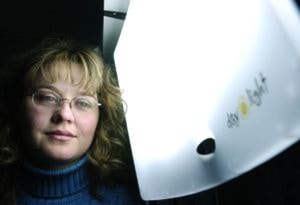The leather massage chair gently pummeling my back was very relaxing.
At least, it was at first.
Suddenly, as if alive, the chair curled up and squeezed my calves. Hard.
Just when it seemed all blood-flow had stopped, it suddenly released and went back to gently battering my back.
I jumped up.
Calf-grabbing massage chairs were not why I was here.
I was here to fight the darkness.
In the North, sunlight is fast disappearing. And Alpine Health Supplies has seen the light.
In fact, it sells the light.
On a shelf, beside a memory-foam bed and some therapeutic pillows was a thin, bright lamp the size of a computer screen.
It gives off between 5,000 and 10,000 lux units, said storeowner Shana MacLean.
The average light only gives off 700 lux.
According to the voluminous promotional literature, these lights can cure everything.
Well, not everything.
But they can do wonders for those afflicted by Seasonal Affective Disorder, or SAD, said MacLean.
SAD is a form of depression that usually occurs in the winter, when sunlight begins to wane.
It’s characterized by excessive tiredness, weight gain, social withdrawal, irritability, difficulty concentrating, carbohydrate cravings and a decreased sex drive.
If these symptoms are manageable, it’s called the winter blues, said MacLean.
But in extreme cases, it can be debilitating.
About six years ago, a number of people came into MacLean’s store with similar complaints.
“They said, ‘I cannot get my butt out of bed in the wintertime, I want to sleep all the time, every winter I come close to divorcing my spouse, what can I do?’” she said.
Having read about the therapy lights, MacLean decided to give them a try.
“I got a big response, and its been growing ever since,” she said.
The lights can cost more than $500, but MacLean sells cheaper models starting around $200.
“They all do the same thing,” she said.
“So there’s no point selling the really expensive ones.”
To get results, a person has to sit in front of the light in the morning for about 20 minutes. Although some people need almost 45 minutes to get full results.
This is one of the drawbacks, said MacLean.
“A lot of people aren’t willing to get up 20 minutes earlier.”
But if a person can’t spare those 20 minutes in the morning, there are pocket-sized lights that can be used at work, she said.
“And you don’t have to look at the light,” said MacLean.
“You shouldn’t stare at it, you have to treat it like the sun.
“But you must bathe your face in it, because it’s absorbed through the eyes.”
The light triggers a chemical reaction in the brain that alters a person’s hormones, she said.
“In the winter, and when a person’s sleeping, their melatonin is quite high and when they’re awake their happy energy chemical, serotonin, should rise.
“But these rhythms can get out of whack when the light changes,” she said.
And the therapy lights are designed to get these rhythms back on track.
That’s why they have to be used in the morning, she added.
If the light’s used at night, it’ll spike a person’s serotonin levels, making it hard to sleep.
MacLean has offered light therapy to a number of customers who were on heavy anti-depressants, she said.
“And now, after using the light, they’re on a very small dose, or on none at all, and can go back to work.”
Often, after someone has started light therapy, co-workers and family are the first to notice a difference in their mood, said MacLean.
“Lots of people are irritable,” she said.
“And all of a sudden they’re not so grumpy and their mood is lighter.”
Light therapy is also great for shift workers, she said.
It helps keep their hormones on the same track as their sleep patterns.
MacLean uses light therapy every day.
“You get low in the wintertime, and you need lots of energy to do what I do,” she said.
Her husband also uses the light when he can find the time, usually standing under the store model for 15 minutes in the morning.
MacLean noticed a spike in light sales when summers were cold and cloudy.
“And three years ago, when we had that really sunny summer and fall, no one came in until November,” she said.
